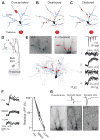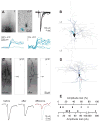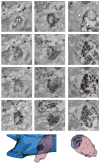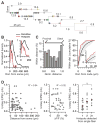Multiple clusters of release sites formed by individual thalamic afferents onto cortical interneurons ensure reliable transmission
- PMID: 21745647
- PMCID: PMC3271052
- DOI: 10.1016/j.neuron.2011.05.032
Multiple clusters of release sites formed by individual thalamic afferents onto cortical interneurons ensure reliable transmission
Abstract
Thalamic afferents supply the cortex with sensory information by contacting both excitatory neurons and inhibitory interneurons. Interestingly, thalamic contacts with interneurons constitute such a powerful synapse that even one afferent can fire interneurons, thereby driving feedforward inhibition. However, the spatial representation of this potent synapse on interneuron dendrites is poorly understood. Using Ca imaging and electron microscopy we show that an individual thalamic afferent forms multiple contacts with the interneuronal proximal dendritic arbor, preferentially near branch points. More contacts are correlated with larger amplitude synaptic responses. Each contact, consisting of a single bouton, can release up to seven vesicles simultaneously, resulting in graded and reliable Ca transients. Computational modeling indicates that the release of multiple vesicles at each contact minimally reduces the efficiency of the thalamic afferent in exciting the interneuron. This strategy preserves the spatial representation of thalamocortical inputs across the dendritic arbor over a wide range of release conditions.
Copyright © 2011 Elsevier Inc. All rights reserved.
Figures









References
-
- Agmon A, Connors BW. Thalamocortical responses of mouse somatosensory (barrel) cortex in vitro. Neuroscience. 1991;41:365–379. - PubMed
-
- Ahmed B, Anderson JC, Martin KA, Nelson JC. Map of the synapses onto layer 4 basket cells of the primary visual cortex of the cat. J Comp Neurol. 1997;380:230–242. - PubMed
-
- Beierlein M, Gibson JR, Connors BW. Two dynamically distinct inhibitory networks in layer 4 of the neocortex. J Neurophysiol. 2003;90:2987–3000. - PubMed
-
- Benshalom G, White EL. Quantification of thalamocortical synapses with spiny stellate neurons in layer IV of mouse somatosensory cortex. J Comp Neurol. 1986;253:303–314. - PubMed
Publication types
MeSH terms
Substances
Grants and funding
LinkOut - more resources
Full Text Sources
Other Literature Sources
Miscellaneous

